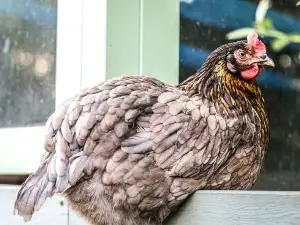
Chickens aren’t always able to feed themselves, a bird may be ill, injured, or both, and this will keep it from being able to feed itself. If this is the case with your bird then you may have to feed the bird yourself.
This article looks at how to syringe feed your chicken.
Table of Contents
Syringe feeding a chicken:
Force-feeding your chicken can be a traumatic experience for both you and your bird, but if it needs to be done then it needs to be done.
Force-feeding a bird is a two-person job, one person needs to hold the bird still and hold her beak open and the other needs to make sure that the tube is inserted properly and that the food is syringed in at a good rate.
What you’ll need:
- A nasogastric tube (pick one with a catheter tip end, you can get this from your local vet)
- A catheter tip 30 or 60 cc syringe, you can pick up one 60 cc syringe or two 35 cc syringes
If you can’t get a hold of the items listed above then you can create a makeshift one using items you can get at a fish supply store, this is what you’ll need:
- One 60 cc or two 30 cc syringes
- A length of air hose tubing
What to do:
Measure the length between your bird’s crop and her mouth, and add a couple of inches to this, then cut your air tubing at this length.
Smooth the end of the tubing by melting it using the fire from a match. Smoothing the end of the tube will keep the scratchy plastic end from injuring the bird’s throat as you slide the tube in.
Fill whatever syringe you’re using with the bird’s food
If you’re using the fish tank store tube, attach this to the end of the syringe. Attach the catheter tube to the end of the syringe if that is what you’re using.
Once the tube is secure, get the bird to open its mouth, or do this yourself. Look for the bird’s glottis, the glottis is an opening at the base of the bird’s tongue.
When moving the tube into the bird’s mouth make sure to avoid getting the tube into the glottis, the glottis is the opening of the bird’s windpipe, if the tube and food get into the bird’s windpipe then the bird will asperate.
Warm the tube and gently slide it into the bird’s throat, if there is resistance as you go down the bird’s throat then you’ve hit a bend in the bird’s neck.
If this happens, carefully move the tube back up the bird’s throat, reposition the bird’s neck to give room for the tube, and keep moving down the bird’s throat.
Once the tube is far down enough, push the syringe plunger to get some of the food into the bird’s crop. Do not squirt the food down, go slowly and at a consistent pace.
The bird may or may not be able to take 2 syringes of food, check how the bird is doing after you’ve given it one syringe of food.
If the bird has room for more food, remove the syringe and switch it for the other one, do not remove the tube from the bird’s throat
If you realize that the food is coming up, gently but quickly remove the tube and let the liquid drain, do this for only a second.
After this, quickly allow the food to drain into the bird’s crop, holding the bird’s head up as you do this. If you don’t do this then the bird can aspirate and die.
Once you’re done feeding, add some air into the syringe and syringe some of it into the bird through the tube to force any leftover food left in the tube into the bird, remove the tube after doing this
If you can get a hold of one, you can feed the bird using a crop needle. These instruments are specially designed to help take food or medication further down the bird’s throat while keeping the chances of the bird aspirating to a minimum.
What to syringe feed a chicken:
You can syringe feed your chicken some baby bird food mixed in with some warm water (Kaytee exact baby bird food is a good option), nonlay crumble (lay crumble has too much calcium) or pellets soaked in warm water then pureed in a blender until smooth.
Chickens can be fed about 140 cc of feed per day, you can feed the bird 60 – 70 cc of feed per feeding twice a day depending on how the bird’s crop empties.
If you enjoyed this article then you may also be interested in other chicken related articles. Here are some articles that you may be interested in: Home Remedies For Chicken Pecking, Chickens Pecking Each Other Bloody, Can You Stop Chickens From Pecking Each Other Using Vinegar?, Pedialyte For Chickens, Chicken Swollen Foot, Not Bumblefoot

